How do you design a content strategy that attracts engineering management at enterprise companies looking for highly technical consultants?
What kind of content do you write that will get the attention of busy executives and department heads?
This is the challenge that Modern Web came to us with when we first met.
Modern Web is a platform that connects medium to enterprise businesses with highly specialized, very experienced software development teams.
So unlike, say, Upwork, where a small business owner might look for someone to tweak their WordPress site, on Modern Web, a Fortune 500 company would hire 3 node.js consultants with a decade of experience each for 8 months — very different.
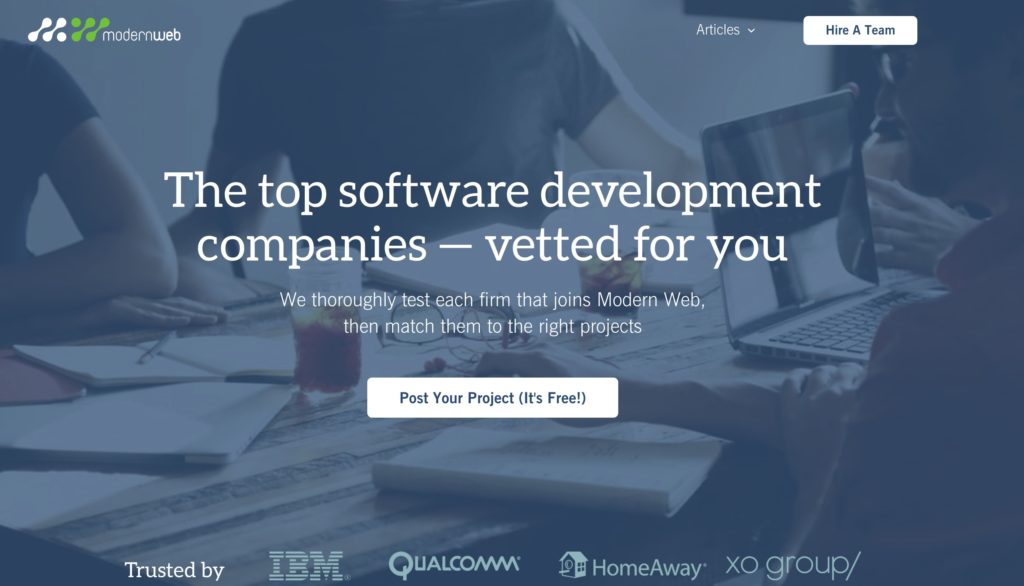
They had tried (for two years) to write content that would attract their target customers. When we looked at their blog we saw a large amount of highly technical content:


It wasn’t working.
The problem was: their old content strategy did a great job of attracting other developers, when the audience they really wanted were the department leaders that would hire development agencies and consultants.
Our Approach: A Customer-Focused Content Strategy
Our process, as always starts with a deep dive into their customers (we’ve written about user research extensively before).
Step 1: Extensive User Research to Define the “Who”
We looked at past customers of the agencies Modern Web worked with, and almost all of the projects were enterprise consulting engagements — where the agency would help the enterprise company transition to new technology — specifically around a development language called node.js.
They already had lots of technical articles around node.js development, but they were highly technical and thus attracted developers instead of executives inside of these types of companies.
From our research, oftentimes executives inside of these enterprise companies weren’t coding and therefore wouldn’t be reading the technical content that was being produced. Executives cared about higher level problems, such as hiring, retaining employees, improving technology infrastructure and staying ahead of the competition.
In the end we decided that we should focus on writing content that would attract technology executives inside of enterprise companies.
That was our “who”.
We should note who this “who” did not include:
- We weren’t going to write for startup founders and employees. Yes, they had a few deals with startups, but they were not the best, most ideal customers. They were just, well, customers.
- We weren’t gong to write for mid-size, family owned businesses. Again, this was a “pretty good” customer segment, but with a different organization structure than enterprise companies and thus different pain points (see step 2 below).
- We for sure weren’t going to write for developers, as we explained above.
So, next, once we define who we’re targeting, we then focus on understanding what their pain points are in depth. This is what leads us to a content strategy.
Step 2: Figure out their actual, day to day pain points
As we alluded to above, for these target customers, we learned that their day to day pain points were pretty far away from code details. Instead, they consisted of things like:
People Pains
- How do I find better talent? (This is huge, for almost anyone in manager level positions. The higher up, the more they stress about hiring.)
- How do we retain more of our top talent?
- How do I get buy-in for other executives and the board?
Technology Pains
- Should we migrate to a different tech stack? If so, which?
- We’re thinking of making a major architecture change, what are the risks?
- Are there examples of other companies like ours that have done something similar?
Step 3: Finally, build a content strategy
A heavy emphasis of the content creation part of our G&C Process is that the content has to have originality and uniqueness to it. We don’t just create, for example, beginner level “How-to”content that’s similar to a bunch of other “How-to’s”in the space.
After doing more research we learned that there were many enterprise companies that had recently switched from an older web framework like Java to node.js. We felt that telling those stories would be perfect content for attracting this target persona.
Here’s why:
- They would have built-in social proof. Managers and executives love hearing what other large organizations like theirs are doing and how they did it.
- The stories would be original. From what we could tell, a lot of these “migrating web frameworks from X to Y” stories were not all over the internet, in fact they were very hard to find.
- The problems overcome in these stories would be highly specific and resonate with our target personas.
Sourcing Stories
In our demand for originality, we treat content marketing for our clients more like journalism than blogging. We want to turn their blog into a premier source for deeply insightful, original, educational, or entertaining content in their space.
So, we went looking for experts that had first-hand experience setting up, migrating, or using node.js in backend web development at enterprise or large organizations.
You can read our article on using subject matter experts to produce content here.
- We asked the Modern Web founders for introductions to people in the industry they knew.
- We looked for slideshare presentations and presentations from industry conferences for people who had spoken about transitioning to Node.js, then we sent cold emails/tweets to them.
- We scoured articles, forums, and Quora to see which enterprise companies had recently switched to node.
- We searched YouTube for videos of people who had given presentations on Node.js.
- We looked at node.js niche sites to find existing stories and discussions.
In the first two months, we secured interviews with senior engineers that had direct, firsthand experience on transitioning their company to node from these enterprise businesses:
- Cars.com
- DirecTV
- Groupon
- Homeaway
Our Article Production Process: Originality, Specificity, and Storytelling
Once we secure interviews like these, we do extensive background research on the person we’re interviewing and the topic. We don’t just walk into an interview cold. We read previous articles or posts they’ve written, watch presentations or talks they’ve given, etc., so we walk into the conversation with one to two angles for the story already in mind.
We come prepared with a list of questions for the subject matter expert and get their perspective and experiences on the topic. This is the key to writing content that isn’t high level and that is relatable to the reader.
Oftentimes, we’ll go into the story thinking we’re going to tell the story from one unique angle, and as we get deep into the interview, the person we’re interviewing will say something interesting that steers the story in a completely new direction.
That’s why it’s important to have our content strategist, writer, and ourselves on the calls so we can listen for what’s the most compelling part of the subject matter experts’ story.
We asked the writer of two of these pieces, Nathan Collier, his opinion on it and here’s what he said about getting on the phone:
“You can get the really specific details of the story because you have the opportunity to ask follow-up questions. You just don’t get that when you’re only talking to someone by email or over text.”
Immediately after the call, while the interview is fresh on our minds, we discuss potential angles for the story extensively:
- What were the most interesting aspects about what they said?
- What pain points did they mention that other target customers have?
- What’s the best hook for this story?
At this early stage, we also started thinking of promotion while we were creating the article. For example:
- What communities could we share these stories with?
- Are there influencers who would also enjoy sharing this with their audience?
You can read our article on community content promotion here.
From our perspective, it’s the process above coupled with our team of writers with journalism (not marketing) backgrounds that makes the stories we produce effective. We’re going for magazine quality content, not content that any other marketer could produce.
Promotion and Traffic Results
The first three articles we produced for Modern Web were:
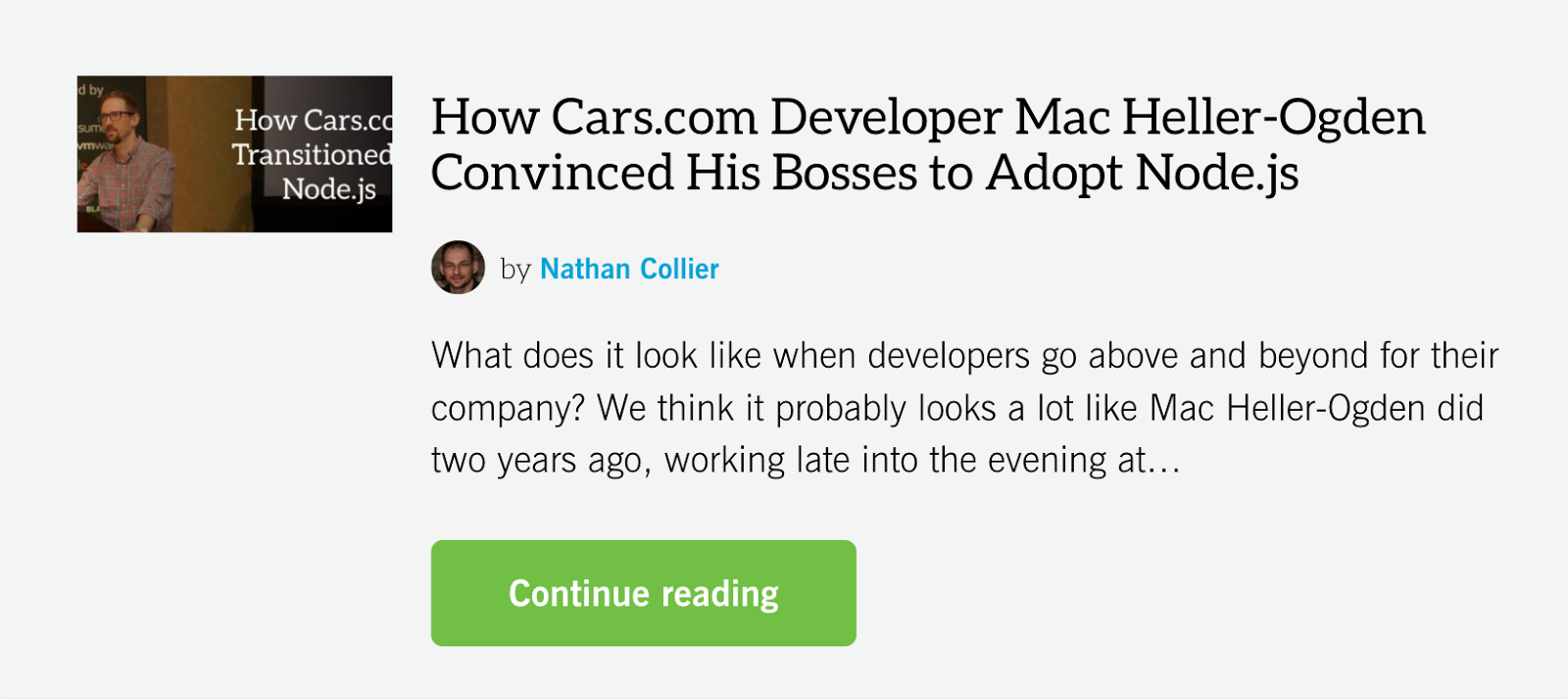
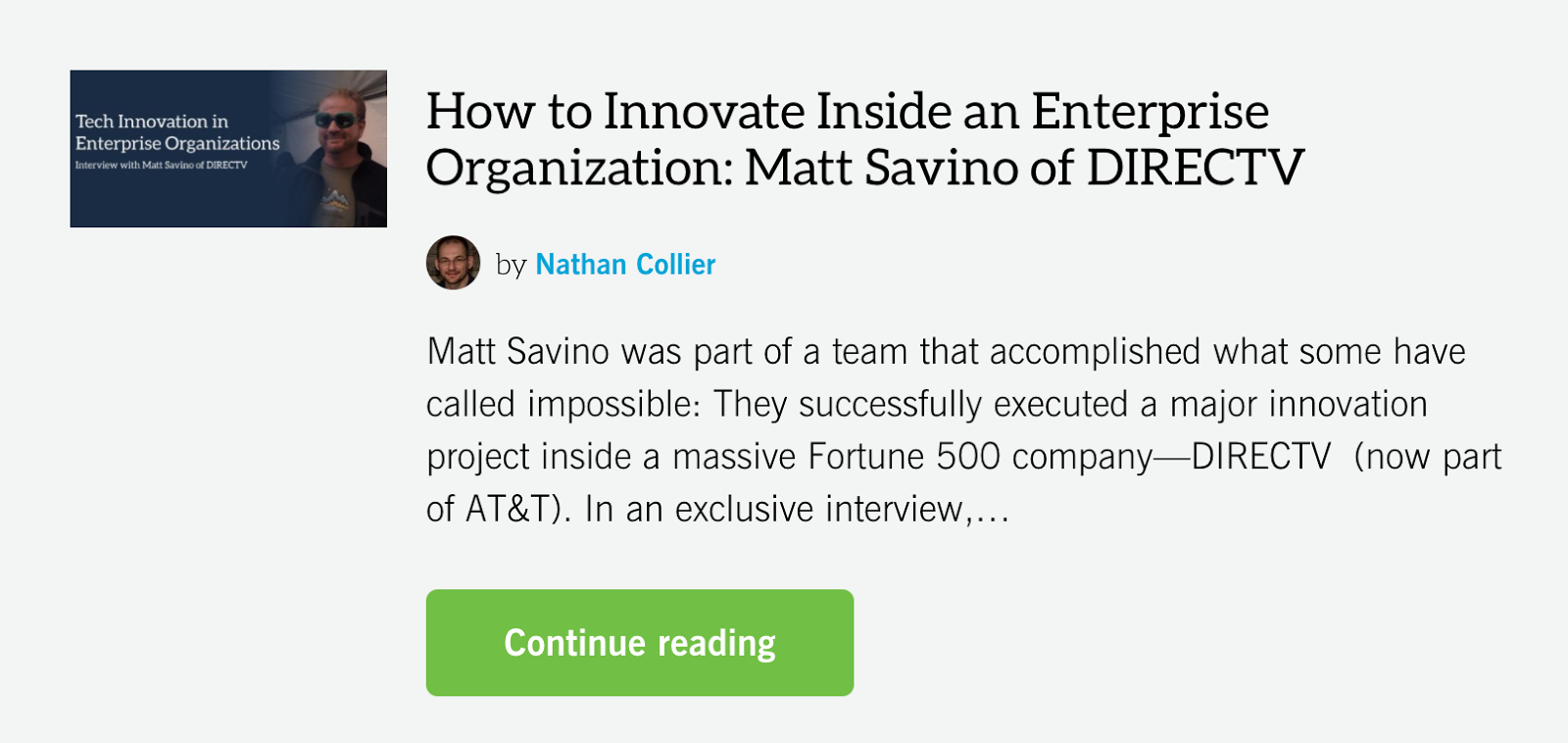

In 3 weeks, they accumulated over 10,000 pageviews, 9,500 unique pageviews and had an average time on page larger than 9 minutes.

The bulk of this traffic came to one piece in particular, an interview with a senior developer who helped transition Cars.com to node.js.
Content Promotion
Typically when content marketers or agencies publish content, “promotion” means sharing on a few social channels: Twitter, LinkedIn, Facebook. This rarely works. So even if you nail the process from the beginning to this point and produce an amazing piece perfectly suited to your target audience’s pain points, it won’t get enough traffic to make a difference without careful promotion.
Our promotion process is a lot more involved. At a high level, it consists of targeting publications and online communities that we think technology executives might frequent. After identifying the channels, we organized them in the spreadsheet below.
This serves as our method of tracking the various channels we promote in as well as brainstorming new ideas for promotion.
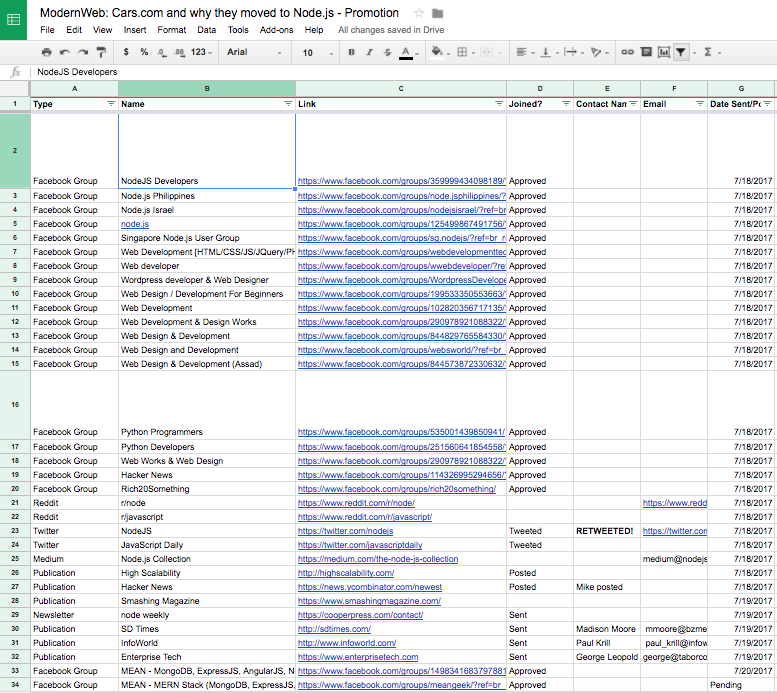
Much of the actual work around promotion can be done prior to the article being finished. We call this “Pre-promotion” work and it consists of joining relevant Facebook groups, Linkedin groups, Google+ groups, Subreddits, and collecting press contacts.
After searching for journalists, influencers, and publications that serve our audience, we drafted pitches and social media copy to use for post descriptions.
We paid close attention to the language used on each platform when promoting. Each group will have its own unique language and it’s very important to understand their culture.
Content Promotion Example: Node.js Reddit (r/node)
Here’s an example from Reddit. We submitted this post to r/node since the community is likely to be happy to hear a Node success story.
Note that the title we used was conversational and less like a proper journalistic headline – this suits the audience of Reddit well. All of these subtle, but important, decisions are made by our content strategists, who study the audience and communities in depth before posting.
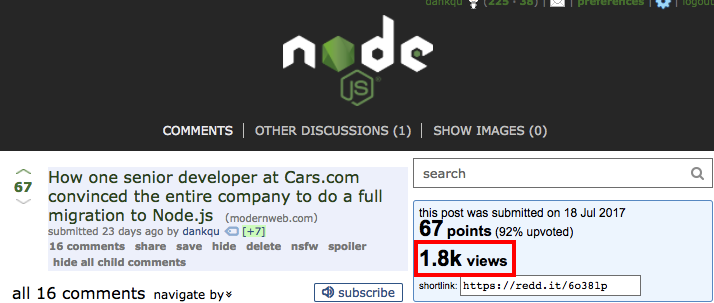
Here, you can see the post attracted 1.8k views, which resulted in Reddit being the 4th highest traffic source for this piece.
Reddit was just one example. The spreadsheet above gives a snapshot of the various groups, influencers, newsletters, and niche publications we went after.
In the end, one big win we got for this article was having it picked up by the node.js foundation, who emailed it to their email newsletter:
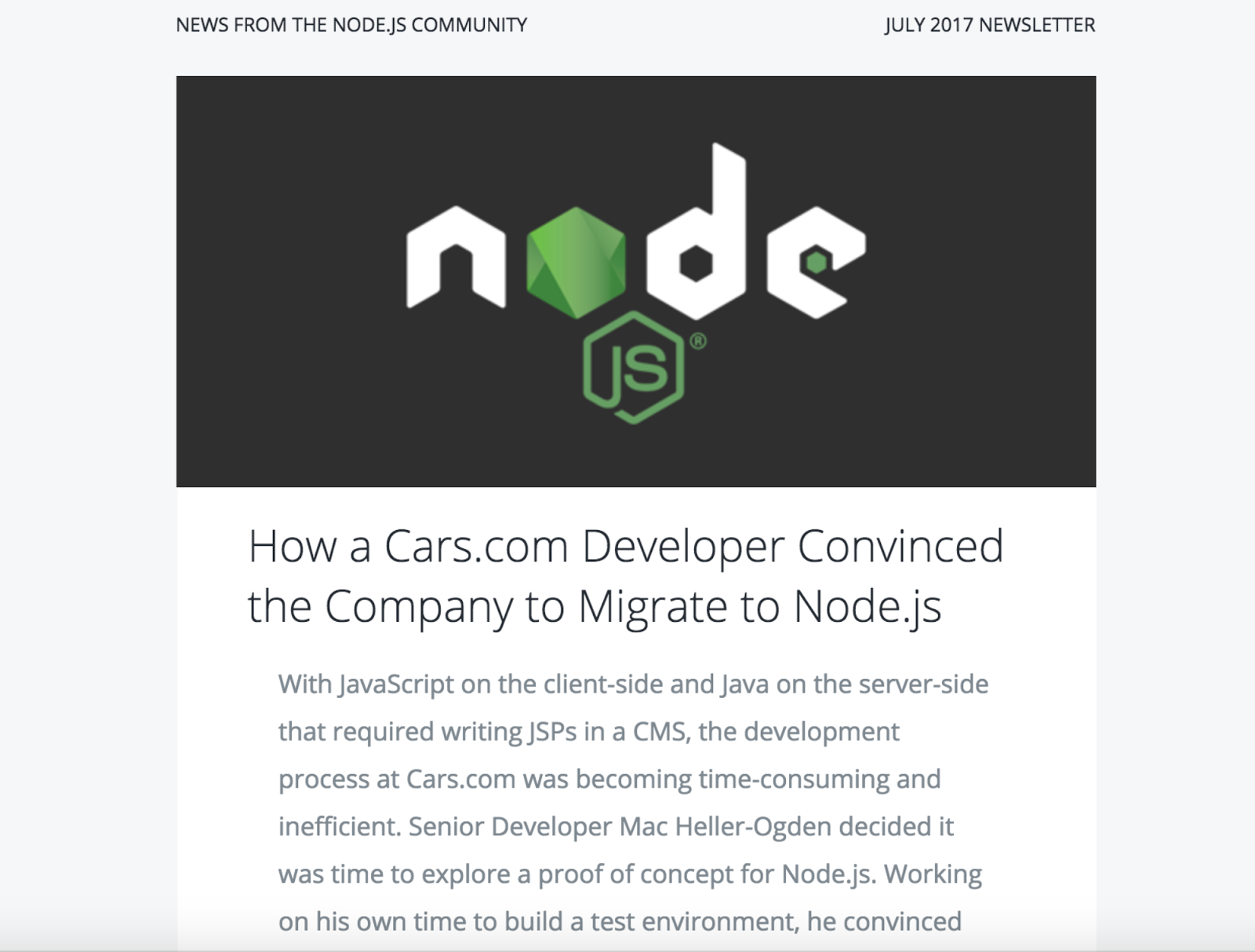
This newsletter is highly specific to our target audience, IT executives and managers looking for consultants to help them transition backend frameworks.
Note that these results aren’t possible without each part of our process working together, in sequence.
- Without user research, content will not be focused on the ideal customer and their pain points.
- Without user research, you can’t create a thorough, highly targeted promotion spreadsheet.
- Without focused, unique, original content, promotion will be far more difficult.
- Without focused, specific content, even if you get traffic, it will be difficult to convert it into signups, free trials, or leads.
Interested in getting these results for yourself?
If you’re interested in transforming your content marketing and getting traffic to articles that are carefully crafted to appeal to your target audience — not just any audience, here’s how working with us contrasts with the traditional content marketing approach:
- User Research: Instead of starting with content first and doing no user research, we first seek to deeply understand who your best customers are and what their pain points are. This involves extensively interviewing multiple members of your team, reading customer feedback data, launching additional user research campaigns and more.
- Content Strategy: Instead of rewriting content that’s already been written, we find and interview subject matter experts and find angles that are unique and original. This turns your company blog into a premier source of original content in your space.
- Content Promotion: Instead of tweeting the article out from the company account a few times and hoping for traffic, we create extensive promotion plans well before publishing, which includes communities and groups, influencers, and publications to pitch to.
If you’d like to apply to work with us, please email devesh@www.growandconvert.com, and let us know:
- Your company
- Your role in the company
- Your blog URL
- Average monthly blog traffic (rough estimate is fine, starting a blog from scratch is fine)
- Your 6 month content marketing goals
- How much internal or external resources have been devoted to content marketing so far
